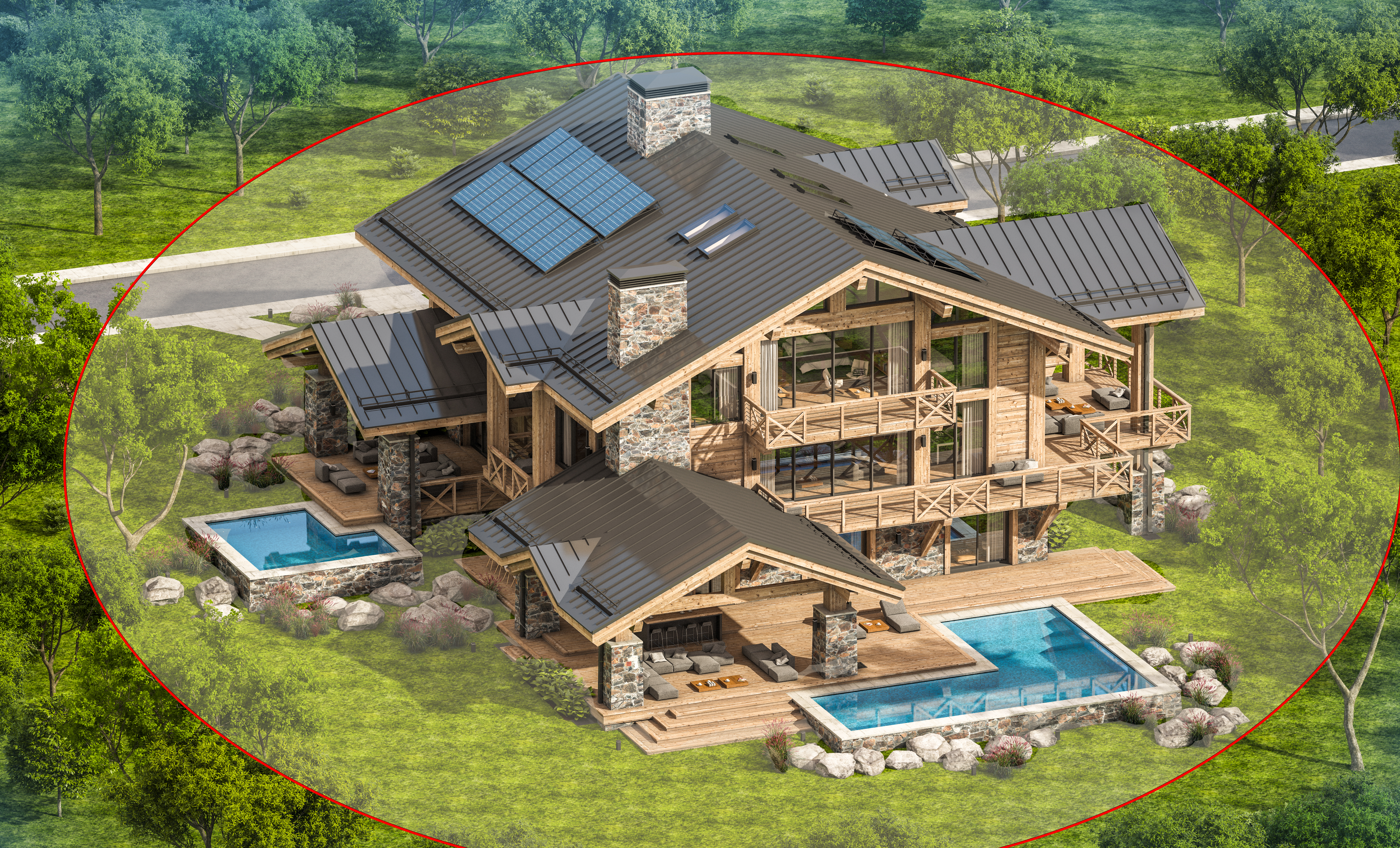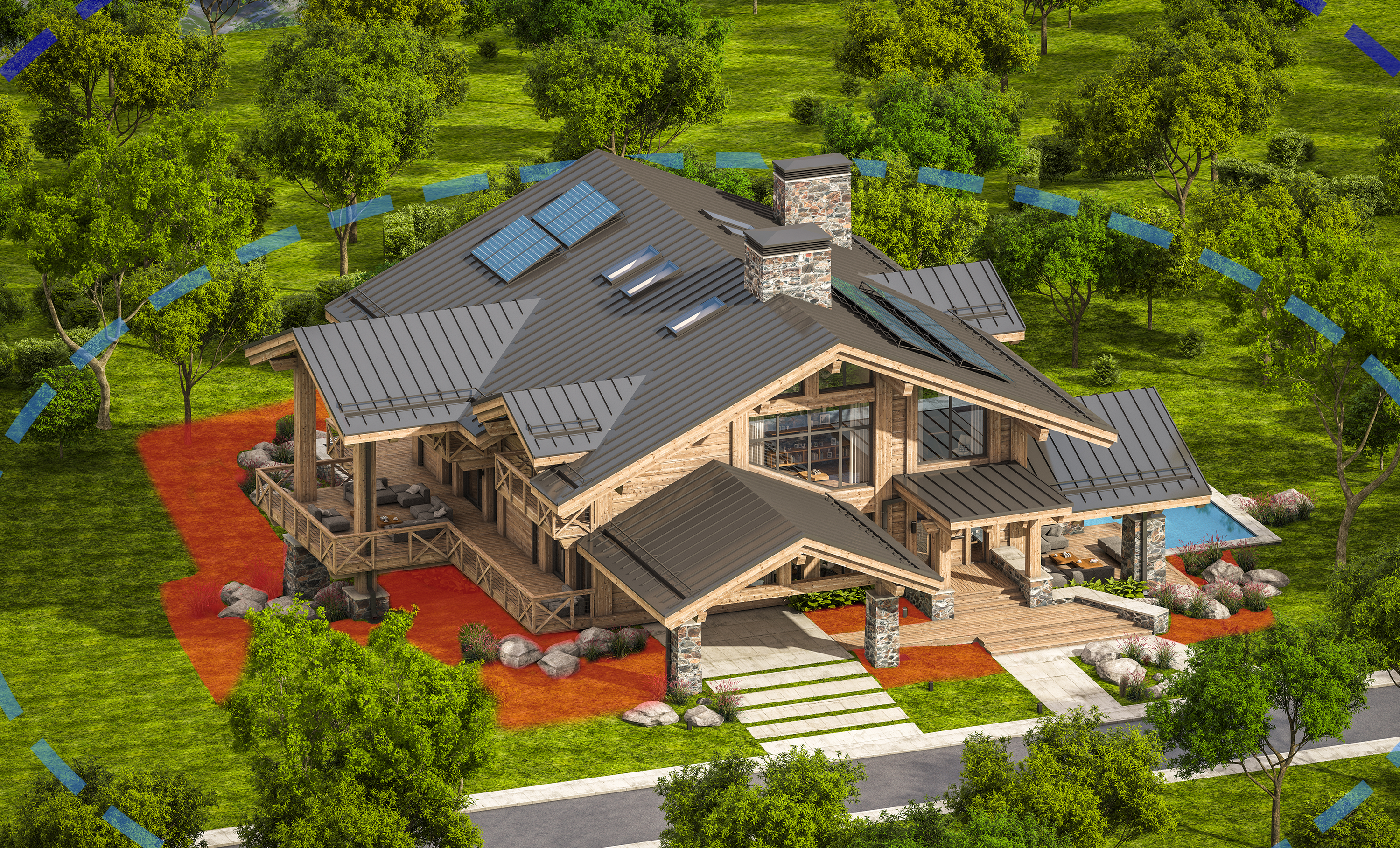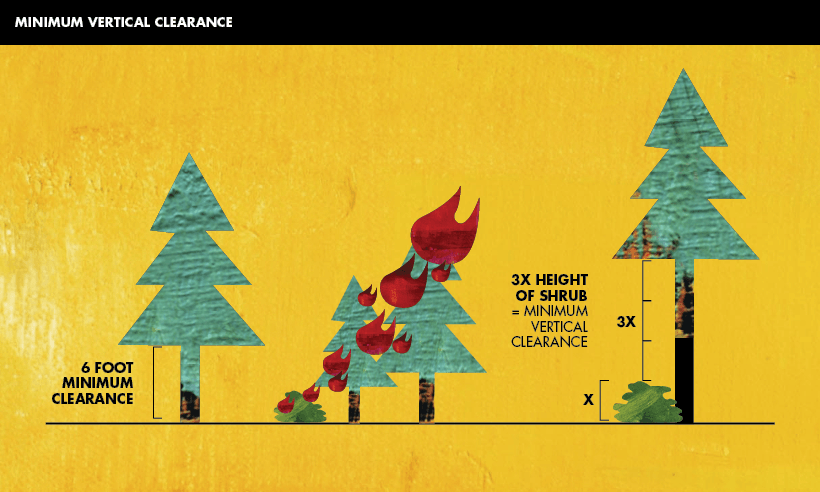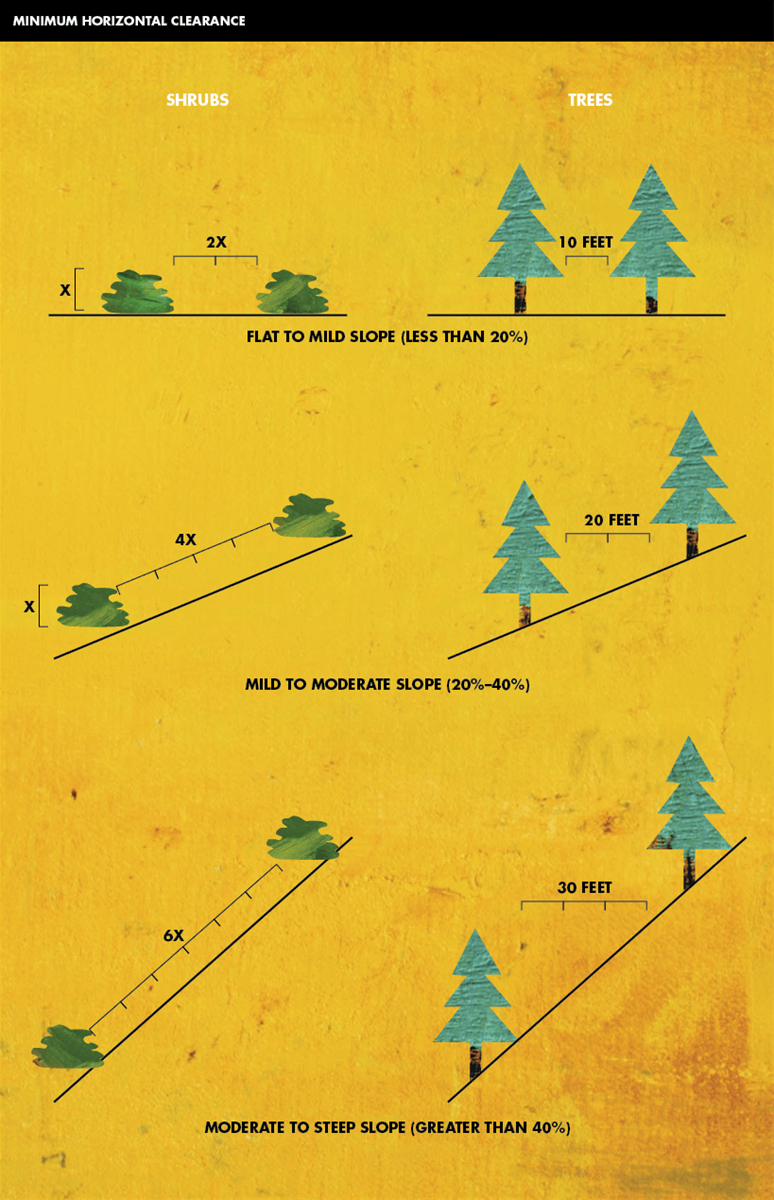What Is Defensible Space?
Defensible space is essential to improve your home’s chance of surviving a wildfire.
In UC ANR Publication 8695, Valachovic, Quarles and Swaim describe Defensible space as a “term used to describe actions to take in zones around a home that involve careful selection, location and maintenance of vegetation and other combustible materials on a property. The goal of defensible space is to
- eliminate pathways for a wildfire to burn directly to the home
- reduce radiant heat exposures
- reduce the potential for embers to ignite vegetation and other combustible materials adjacent to the home
- provide a safe place for fire personnel to defend the home and allow safe routes for evacuation.”
Defensible space is the buffer you create between a building on your property and the grass, trees, shrubs, or any wildland area that surround it. Defensible space will help slow or stop the spread of wildfire and protect your home from catching fire – either from direct flame contact or radiant heat. Defensible space is also important to help protect firefighters when they are defending your home.
Your home may be the most valuable investment you ever make. If you live in a high-risk fire hazard area, protect against the chance of losing that investment by creating defensible space and hardening your home with fire-resistant construction materials and design.
Creating defensible space does not mean you need a ring of bare dirt around your home! Through proper planning, you can have both a beautiful landscape and a fire safe home.
Valachovic, Quarles and Swaim further state that “implementing an effective defensible space strategy requires that overgrown, dense, or unmaintained vegetation creates significant vulnerabilities and that it can enable fire to burn to the home through several fire-spread scenarios, including ember ignition of vegetative debris on the ground and ember ignition of vegetative debris on roofs. Ignition of outbuildings can also occur due to emergency ignition of nearby combustibles. These fire=spread scenarios can also result in radiant heat or flame contact exposures to the home. Additional fuel reduction strategies, such as reducing vegetation along access routes or limbing trees to allow for easier passage of fire equipment, should be implemented to create safe routes for evacuation.”
Keep your property lean and green to help protect your family and home.
Defensible space, coupled with home hardening, is essential to improve your home’s chance of surviving a wildfire. Defensible space is the buffer you create between a building on your property and the grass, trees, shrubs, or any wildland area that surround it. This space is needed to slow or stop the spread of wildfire and it helps protect your home from catching fire—either from embers, direct flame contact or radiant heat. Proper defensible space also provides firefighters a safe area to work in, to defend your home.

Defensible Space Zones
Zones 1 and 2 currently make up the 100 feet of defensible space required by law. Assembly Bill 3074, passed into law in 2020, requires a third zone for defensible space. This law requires the Board of Forestry and Fire Protection to develop the regulation for a new ember-resistant zone (Zone 0) within 0 to 5 feet of the home by January 1, 2023. The intensity of wildfire fuel management varies within the 100-foot perimeter of the home, with more intense fuels’ reduction occurring closer to your home. Start at the home and work your way out to 100 feet or to your property line, whichever is closer.

Zone 0 – Ember-Resistant Zone
Zone 0 extends 5 feet from buildings, structures, decks, etc.
The ember-resistant zone is currently not required by law, but science has proven it to be the most important of all the defensible space zones. This zone includes the area under and around all attached decks, and requires the most stringent wildfire fuel reduction. The ember-resistant zone is designed to keep fire or embers from igniting materials that can spread the fire to your home. The following provides guidance for this zone, which may change based on the regulation developed by the Board of Forestry and Fire Protection.
- Use hardscape like gravel, pavers, concrete and other noncombustible mulch materials. No combustible bark or mulch
- Remove all dead and dying weeds, grass, plants, shrubs, trees, branches and vegetative debris (leaves, needles, cones, bark, etc.); Check your roofs, gutters, decks, porches, stairways, etc.
- Remove all branches within 10 feet of any chimney or stovepipe outlet
- Limit plants in this area to low growing, nonwoody, properly watered and maintained plants
- Limit combustible items (outdoor furniture, planters, etc.) on top of decks
- Relocate firewood and lumber to Zone 2
- Replace combustible fencing, gates, and arbors attach to the home with noncombustible alternatives
- Consider relocating garbage and recycling containers outside this zone
- Consider relocating boats, RVs, vehicles and other combustible items outside this zone
Zone 1 – Lean, Clean and Green Zone
Zone 1 extends 30 feet from buildings, structures, decks, etc. or to your property line, whichever is closer.
- Remove all dead plants, grass and weeds (vegetation).
- Remove dead or dry leaves and pine needles from your yard, roof and rain gutters.
- Remove branches that hang over your roof and keep dead branches 10 feet away from your chimney.
- Trim trees regularly to keep branches a minimum of 10 feet from other trees.
- Relocate wood piles to Zone 2.
- Remove or prune flammable plants and shrubs near windows.
- Remove vegetation and items that could catch fire from around and under decks, balconies and stairs.
- Create a separation between trees, shrubs and items that could catch fire, such as patio furniture, wood piles, swing sets, etc.
Zone 2 – Reduce Fuel Zone
Zone 2 extends from 30 feet to 100 feet out from buildings, structures, decks, etc. or to your property line, whichever is closer.
- Cut or mow annual grass down to a maximum height of 4 inches.
- Create horizontal space between shrubs and trees. (See diagram)
- Create vertical space between grass, shrubs and trees. (See diagram)
- Remove fallen leaves, needles, twigs, bark, cones, and small branches. However, they may be permitted to a depth of 3 inches.
- All exposed wood piles must have a minimum of 10 feet of clearance, down to bare mineral soil, in all directions.
Zone 1 and 2
- “Outbuildings” and Liquid Propane Gas (LPG) storage tanks shall have 10 feet of clearance to bare mineral soil and no flammable vegetation for an additional 10 feet around their exterior.
Local Ordinance
Many local government agencies have local ordinances for defensible space or weed abatement. These local ordinances will often be more stringent than the State’s minimum requirements listed above (e.g., San Diego County requires 50 feet of clearance in Zone 1). Check with your local fire department or fire protection district for any additional defensible space or weed abatement ordinance requirements.
Plant and Tree Spacing
The spacing between grass, shrubs, and trees is crucial to reduce the spread of wildfires. The spacing needed is determined by the type and size of brush and trees, as well as the slope of the land. For example, a property on a steep slope with larger vegetation requires greater spacing between trees and shrubs than a level property that has small, sparse vegetation.
Vertical Spacing
Remove all tree branches at least 6 feet from the ground.
Allow extra vertical space between shrubs and trees. Lack of vertical space can allow a fire to move from the ground to the brush to the treetops like a ladder. This leads to more intense fire closer to your home.
To determine the proper vertical spacing between shrubs and the lowest branches of trees, use the formula below.

Example: A five-foot shrub is growing near a tree. 3×5 = 15 feet of clearance needed between the top of the shrub and the lowest tree branch.
Horizontal Spacing
Horizontal spacing depends on the slope of the land and the height of the shrubs or trees. Check the chart below to determine spacing distance.

AB38 Resale Inspections
Space Inspections and Compliance Reports
for Real Estate Transactions in High or Very High Fire Hazard Severity Zone.
What is AB-38?
As of July 1, 2021, California Civil Code Section 1102.19 requires a seller of real property located in a High or Very High Fire Hazard Severity Zone (FHSZ) within the State Responsibility Area (SRA) or Local Responsibility Area (LRA), to provide the buyer with documentation stating the property is in compliance with the requirements of Public Resources Code (PRC) Section 4291 for properties within the SRA or local vegetation management ordinances for properties within jurisdictions (SRA or LRA) that have enacted an ordinance requiring an owner to achieve compliance with PRC 4291 or Government Code 51182. The law also requires that if documentation demonstrating compliance cannot be obtained by the close of escrow, a written agreement showing that the buyer agrees to obtain documentation of compliance to either PRC 4291 for properties within the SRA, or a local ordinance for properties within jurisdictions that have enacted an ordinance, within one year of the close of escrow.
Please click on the link below to look up your property address.
https://gis.marinpublic.com/lookup/FireLookup/default.aspx
If your property is located in the high or very high fire hazard zone, fill out the Novato Fire resale inspection request form.
INSPECTION CRITERIA - ALL APPLICANTS MUST READ!
Fire Inspectors will look for the following during the inspection:
- All properties are required to meet the combustible vegetation clearance requirements of California Fire Code Sections 4907.2 & 4908, PRC 4291 and Ca Gov Code 51189.
- Maintenance of “Defensible Space” for a distance of 30-150 feet (or to the property line) from all structures is required. This includes clearance of all accumulated dead vegetation on the property.
- Removal of all fire-hazardous vegetation within 30' structures, up to 150 feet when topographical or combustible vegetation types necessitate removal. Examples of fire-hazardous vegetation includes but is not limited to ALL dead vegetation, juniper, bamboo, pampas/jubata/fountain grasses, French and scotch broom.
- Any tree limbs extending within 10 feet of a chimney outlet, or 6 feet from the roof, shall be removed.
- Trees adjacent to or overhanging a building must be completely free of dead wood. Tree limbs should be pruned away from buildings.
- Address numbers must be plainly visible and legible from the road fronting the property. Numbers must be at least 4 inches tall and a color that contrasts with their background (an address number painted on a curb is not acceptable).
- Combustible vegetation shall be cleared within 10 feet (horizontally) of roadways and/or driveways, and 15 feet of overhead clearance must be provided.
- A spark arrestor of heavy wire mesh with openings between 3/8 and 1/2 inch is required on all chimneys.
- Additional items may be required for compliance with state law or local ordinances related to wildfire hazards upon inspection.
- What is a DSI Compliance Report?
- A copy of the completed compliance inspection report that shows proof the property has been inspected and has passed that inspection, within six (6) months prior to entering a sales contract.
What if my property does not pass the inspection?
- If your property does not pass on the first attempt, the inspector will explain what work needs to be completed and schedule another appointment at a later date. If the property will not meet compliance with PRC 4291 standards or a local vegetation management ordinance, the seller and the buyer shall enter into a written agreement pursuant to which the buyer agrees to obtain documentation of compliance within one year after closing escrow.
What if the seller had received an inspection recently?
- The seller shall provide the buyer with documentation of compliance with the local vegetation management ordinance from the NFPD or PRC 4291 from CAL FIRE obtained in the 6-month period preceding the date the seller enters into a transaction to sell the real property.
What if the seller cannot obtain the required documentation before close of escrow?
- If the seller has not obtained documentation of compliance with the local vegetation management ordinance from the NFPD or PRC 4291, the seller and buyer shall enter into a written agreement whereby the buyer agrees to obtain documentation of compliance with the local vegetation management ordinance or PRC 4291 within one year of the date of close of escrow.
IS MY HOUSE IN A HIGH FIRE HAZARD ZONE?
CALIFORNIA HOME HARDENING & DEFENSIBLE SPACE LAWS
| State of California Government Code 5182 471 Downloads | 81.79 KB | |
| State of California PRC 4291 431 Downloads | 104.2 KB |
LOCAL & COUNTY VEGETATION MANAGEMENT LAWS & REGULATIONS
El DORADO COUNTY
| Title | Hits | |
|---|---|---|
| EL DORADO HILLS FIRE DEPARTMENT UNIMPROVED PROPERTY HAZARD ABATEMENT STANDARD 110 Downloads | 539 | |
| CAMERON PARK COMMUITY SERVICE DISTRICT “WEED AND RUBBISH ABATEMENT 121 Downloads | 425 | |
| El Dorado County Vegetation Management and Defensible Space Ordinance 612 Downloads | 24 | |
| El Dorado Hills Fire Department Vegetation Management on Unimproved Properties 319 Downloads | 3 | |
| Placerville Hazardous Vegetation and Combustible Materials Abatement Ordinance 305 Downloads | 1 |
